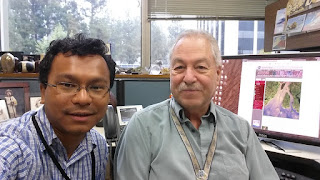नेशनल एरोनोटिक्सस एण्ड स्पेश एडमिनिस्ट्रेशन (नासा)को जेट प्रपल्सन ल्याबमा कार्यरत नेपाली वैज्ञानिक डा नवीनकुमार मालाकार नेतृत्वम अनुसन्धानकर्ताकाे एउटा समूहले भूउपग्रहबाट प्राप्त तस्विरका आधारमा एउटै गणितीय विधिबाट पृथ्वीका विभिन्न स्थानको ताप मापन गर्ने नयाँ ‘एल्गोरिदम’ विकास गरेको हो।
यससम्बन्धी अनुसन्धान निष्कर्षसहितको लेख ‛आइइइइ ट्रान्जाक्सन एण्ड जियो साइन्स एन्ड रिमोट सेन्सिङ सोसाइटीको′ जर्नलमा प्रकाशित भएको छ। यो अनुसन्धानमा मालकारसँगै ग्यालन सी हुले, सिमाेन जे हुक, केली लार्बे, माेनिका कुक र जाेन अार स्कट संलग्न छन्।
अहिलेसम्म फरक–फरक भूउपग्रहबाट प्राप्त तथ्यांकलाई छुट्टाछुट्टै हिसाब गरेर मान (भ्याल) पत्ता लगाइन्थ्यो। भौतिकशास्त्रका शोधकर्ता डा मालाकारले भने, ‛यो एल्गोरिदम पृथ्वीको तापमान जोडिएका तमाम विषयवस्तु अध्ययनमा विश्वव्यापी रुपमै प्रयोग हुनसक्छ। तापमान हिसाबकिताब गर्ने काममा यसले एकरुपता ल्याउनेछ।’
यसअघि पृथ्वी तापमापन अध्ययनमा अप्टिकल डाटा मात्र उपलब्ध हुने गरेकोमा यो शोधको सफलतापछि अब थर्मल डेटा प्रयोग गर्न सकिने भएको छ। ‘सतहमा मापन गरिएको डेटा र स्याटलाइटबाट लिइएको डेटा क्रस भ्यालिडेशन गर्दा मेल खान्छ’, उनी भन्छन्।
यो वैज्ञानिक शोधलेख प्रकाशित भएपछि वैज्ञानिक समुदायबाट राम्रो प्रतिक्रिया आएको डा मालाकार बताउँछन्।
जलावयु परिवर्तनदेखि खेतीबाली अनुसन्धानमा उपयोगीजलवायू परिवर्तनको प्रवृत्ति देखाउन यो एल्गोरिदम उपायेगी हुने मालाकारको विश्वास छ। विगत ४० वर्षमा कुन कालखण्डमा पृथ्वीको तापक्रम कसरी परिवर्तन भएको छ भन्ने तुलनात्मक अध्ययन पनि यसबाट गर्न सकिन्छ। भूसतहको तापक्रमलाई तापसँग सम्बन्धित महत्वपूर्ण विषयवस्तु जस्तैः शहरी जनसंख्यामा बढ्दो तापक्रम (हिट स्ट्रेस)को असर, भेक्टरजनित रोगहरुको अध्ययन आदिमा उपयोग हुनेछ। यसैगरी भूसतहको तापक्रमको दीर्घकालीन प्रवृत्ति आँकलन गर्न पनि यो विधि सहायक हुनेछ।
अनुसन्धानमा युनाइटेड स्टेट्स जियोलोजिकल सर्वे (यूएसजीएस)को चारवटा भूउपग्रह (ल्याण्डस्याट)को सहयोगमा सम्भव भएको हो। ती भूउपग्रहले पृथ्वीलाई १ सय मिटरको रिजोल्यूसनमा अवलोकन गरेका तस्विर तथ्यांकलाई अनुसन्धानमा उपयोग गरिएको छ।
भूउपग्रहरु नम्बर ४, नम्बर ५, नम्बर ७ र नम्बर ८ बाट प्राप्त तस्विरका तथ्यांकलाई मिहिन ढंगबाट विश्लेषण गरिएको डा.मालाकार बताउँछन्। यी भूउपग्रहहरु विभिन्न समयमा यूएसजिएसले प्रक्षेपण गरेका हुन्।
नम्बर ४, ५ भूउपग्रह सन् १९८२ मा प्रक्षेपित गरिएको थियो। नम्बर ७ सन १९९९ र ८ सन् २०१३ मा पृथ्वीको कक्षमा पठाइएको थियो।पृथ्वीका जीवन र जलवायुका लागि तापमान निकै सम्वेदनशील विषय हो। वनजंगल फडानीको निरीक्षण गर्न पनि मेरो अनुसन्धानले विकास गरेको विधि काम लाग्छ’, उनी भन्छन्, ‘किनभने जहाँ रुख काटियो त्यहाँको तापक्रम बढी देखिन्छ र रुखहरु भएको ठाउँमा स्वभाविक रुपले तापक्रम कम हुन्छ।’
मानवजनित क्रियाकलापले भूमण्डलीय पर्यावरणलाई कस्तो असर गरेको छ भन्ने विषयको सूक्ष्म अध्ययनको लागि पनि यो प्रविधि उपयोगी हुनेछ। डा मालाकारले विकसित गरेको विधि खेतीयोग्य जमिनको उर्बरता दर परिवर्तन छ कि छैन भनेर विश्लेषण गर्न पनि प्रयोग गर्न सकिनेछ।
‘बालीनालीको बिमा गर्ने ठूला बिमा कम्पनीहरुले पनि हाम्रो बिधिलाई उपयाेग गर्न सक्छन्। यो विधिले सिजनको अन्त्यमा कति उत्पादन हुन्छ भन्ने निक्र्योल गर्न सक्छ’, उनी भन्छन्।
‘ब्लाकहोल’ अनुसन्धानकर्ता
अहिले पृथ्वीको तापमान हिसाब गर्ने विधि पत्ता लगाएर ख्याति कमाइरहेका मालाकारले त्रिभुवन विश्वविद्यालयमा स्नातकोत्तर गर्दा भने ‘ब्ल्याकहोल’का शोधकर्ता हुन्। त्यतिबेला उनका गाइड अन्तर्राष्र्टिय ख्यातिप्राप्त भौतिकशास्त्री उदयराज खनाल थिए। विज्ञानमा जे अनुसन्धान गरे पनि त्यसले समाजलाई प्रभाव पार्ने खालको हुनुपर्छ भन्ने सोच त्यतिबेलै भएको उनी सुनाउँछन्। भन्छन्, ‛फिजिक्समा शोध गर्छु भन्ने थियो तर के गर्ने भनेर स्पस्ट मार्गचित्र मसँग थिएन।’
नेपालको त्रिभुवन विश्वविद्यालयबाट भौतिक विज्ञानमा स्नातकोत्तर गरेका उनले युनिभर्सिटी अफ न्यूयोर्क अल्बानीबाट सन् २०११ मा भौतिक शास्त्रमा विद्यावारिधि पूरा गरेका हुन्।
एकवर्ष यता उनी म्यासाच्यूसेट्सको उस्टर स्टेट युनिभर्सिटीमा भौतिक विज्ञानका सहायक प्राध्यापकको रुपमा कार्यरत छन्। त्यसअघि उनी पोष्ट डक्टारल शोध बैज्ञानिकको रुपमा नासाको जेट प्रपल्सन ल्याब, क्याल्टेक कयालिफोर्नीमा कार्यरत थिए। त्यहाँ उनले नासाकै भूउपग्रह मोडिस, भिआइआइआरएस लगायतका तथ्यांकबाट पृथ्वी भूसतहको तापक्रमबारे शोध गरेका थिए।
उच्चशिक्षा अध्ययनका लागि अमेरिका आउनुअघि मालाकार मध्य बानेश्वरस्थित हिमालयन ह्वाइटहाउस कलेजमा फिजिक्स पढाउँदथे। मकवानपुरको हेटौंडामा जन्मेका नबिन मालाकारले भुटनदेवी माविबाट एसएलसी गरेका हुन्। भुटनदेवी मावीका शिक्षकहरुको प्रेरणाकै कारण आफू भौतिक विज्ञानको शिक्षामा आकर्षित भएको उनी सुनाउँछन्।
प्रकाशित १३ कार्तिक २०७५, मंगलबार | 2018-10-30 10:51:36
Publised on nepalkhabar.com
The research paper:
An Operational Land Surface Temperature Product for Landsat Thermal Data: Methodology and Validation Nabin K. Malakar ; Glynn C. Hulley ; Simon J. Hook ; Kelly Laraby ; Monica Cook ; John R. Schott
Preprint is available: https://www.researchgate.net/publication/325231273_An_Operational_Land_Surface_Temperature_Product_for_Landsat_Thermal_Data_Methodology_and_Validation






